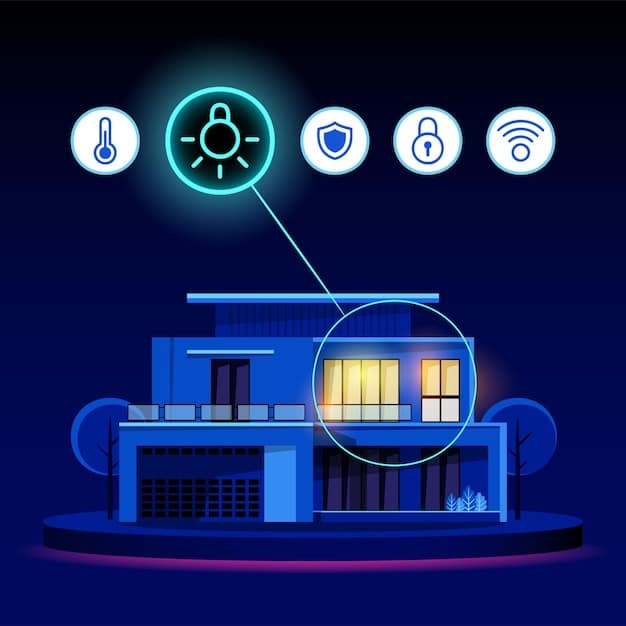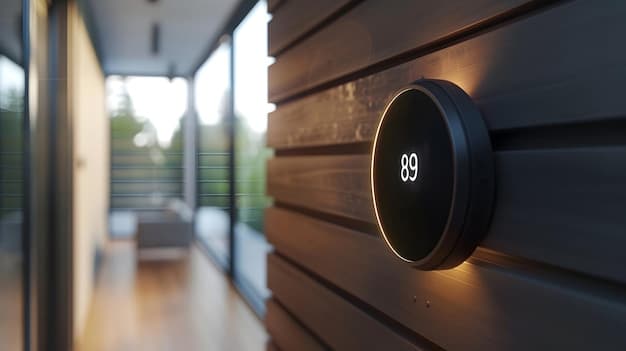Smart Home Security: Reduce False Alarms by 35% in 2025

Anúncios
Achieving a 35% reduction in smart home security false alarms by 2025 is attainable through advanced sensor technology, AI-powered analytics, professional installation, optimized user settings, and proactive system maintenance.
In the landscape of modern living, the promise of a secure home often converges with the convenience of smart technology. Yet, for many, the recurring frustration of false alarms casts a shadow on the benefits of these advanced systems. Imagine a future where your smart home security system seamlessly protects your property without the constant false alerts that disrupt peace of mind and, at times, incur unnecessary dispatches. This article delves into how to reduce false alarms by 35% in 2025, transforming your smart home security experience.
Understanding the False Alarm Conundrum in Smart Home Security
False alarms are a persistent challenge for both homeowners and emergency services. They stem from a variety of sources, ranging from environmental factors to user error, and their cumulative effect can lead to alarm fatigue, where legitimate threats are dismissed. This issue not only diminishes the perceived value of a security system but can also result in fines from local authorities and delayed responses to genuine emergencies.
The core of the problem lies in the traditional approach to security sensing, which often relies on simple threshold detections. A sudden gust of wind, a curious pet, or a minor power fluctuation can trigger an alert, leading to unnecessary investigations. Addressing this requires a multi-faceted strategy that leverages technological advancements and user best practices.
Common Causes of False Alarms
Identifying the root causes is the first step toward effective mitigation. Understanding what triggers these alerts allows for targeted solutions.
- Environmental Factors: Changes in temperature, humidity, and air pressure can affect sensor readings. High winds, for instance, can rattle doors or windows, mimicking a break-in attempt.
- Pet Interference: Movement sensors often struggle to differentiate between a human intruder and a family pet, especially larger breeds or active animals.
- User Error: Incorrect entry codes, forgetting to disarm the system, or misplacing key fobs are common reasons for accidental triggers.
- Poor Installation/Placement: Sensors installed incorrectly or in unsuitable locations (e.g., near vents, direct sunlight) are prone to misinterpretation of stimuli.
- Equipment Malfunctions: Aging hardware, low batteries, or faulty wiring can lead to erratic sensor behavior and false positives.
By dissecting these factors, we can then explore proactive measures and technological solutions to create a more resilient and accurate smart home security ecosystem. The goal is to move beyond reactive fixes to a preventive approach that minimizes the incidence of false alarms.
Leveraging Advanced Sensor Technology for Precision
The evolution of sensor technology is pivotal in the quest to reduce false alarms. Modern sensors are increasingly sophisticated, moving beyond simple motion detection to incorporate a broader range of data points for more accurate threat assessment. The integration of multiple sensing modalities allows systems to cross-reference information, significantly reducing misinterpretations.
For instance, combining passive infrared (PIR) motion sensors with microwave or ultrasonic detection creates a more robust detection zone. PIR sensors detect heat signatures, while microwave sensors detect movement. A proper alarm trigger would require both sensors to confirm a presence, effectively filtering out minor disturbances like curtains swaying or dust particles.

Multi-Sensor Integration and Fusion
The future of smart home security lies in sensor fusion, where data from various sensor types is combined and analyzed to form a comprehensive picture of potential threats. This integrated approach elevates the system’s ability to distinguish between benign events and genuine security breaches.
- Acoustic Sensors: These can detect the sound of breaking glass or unusual noises, supplementing motion detection.
- Vibration Sensors: Attached to windows and doors, they trigger only upon significant impact or tampering, ignoring gentle bumps.
- Video Analytics: Cameras equipped with AI can differentiate between humans, animals, and vehicles, reducing alerts caused by passing cars or squirrels in the yard.
- Environmental Sensors: Integrating temperature, humidity, and smoke/CO detectors provides a holistic view, helping to discern environmental anomalies from security threats.
The efficacy of these advanced sensors is further enhanced when they communicate seamlessly within a centralized smart home ecosystem. This allows for a more intelligent and contextual interpretation of events, leading to fewer erroneous alerts and a higher level of trust in the system’s accuracy.
The Role of Artificial Intelligence and Machine Learning
Artificial Intelligence (AI) and Machine Learning (ML) are game-changers in the battle against false alarms. These technologies enable smart home security systems to learn from past events, identify patterns, and make more informed decisions about when to trigger an alert. Instead of relying solely on predefined thresholds, AI-powered systems adapt and improve over time, becoming more adept at distinguishing real threats from nuisances.
For example, an AI algorithm can be trained to recognize the typical movement patterns of pets versus humans, or to ignore the movement of branches outside a window while detecting an actual intrusion attempt. This continuous learning process allows the system to fine-tune its sensitivity, reducing the likelihood of false positives while maintaining vigilance against genuine threats.
Predictive Analytics and Behavioral Patterns
Beyond simple real-time detection, AI allows for predictive analytics, anticipating potential false alarm scenarios before they occur. By analyzing historical data, the system can identify common triggers and adjust its responses accordingly.
- Learning Occupant Behaviors: AI can learn routines, such as when residents typically enter and exit, or when pets are most active, to contextualize events.
- Environmental Adaptation: Systems can adapt to seasonal changes, like increased winds in autumn or heavier rain, and adjust sensor sensitivity to avoid false triggers related to weather.
- Anomaly Detection: Instead of just detecting presence, AI can flag “unusual” presence or behavior – for example, if someone is in a part of the house they don’t usually frequent at a certain time.
Machine learning models continuously refine their understanding of “normal” versus “abnormal” activity, leveraging vast datasets to minimize errors. This intelligent adaptation is key to achieving a significant reduction in false alarms, providing a more reliable and less intrusive security experience for homeowners.
Optimizing Installation and Professional Calibration
Even the most advanced smart home security systems can underperform if not installed and calibrated correctly. Professional installation is a critical factor in mitigating false alarms, as it ensures that sensors are placed optimally and integrated seamlessly with other smart home devices. DIY installations, while appealing for cost savings, often overlook nuances that can lead to frequent false positives, such as incorrect sensor angles or proximity to heat sources.
A certified installer possesses the expertise to assess your home’s unique layout, identify potential blind spots, and recommend the best sensor types and placements. They can also calibrate sensitivity settings specific to your environment, accounting for factors like pets, children, or nearby traffic, thereby fine-tuning the system to your lifestyle without compromising security.
Strategic Sensor Placement and Zone Configuration
The strategic placement of sensors and intelligent zone configuration are paramount for preventing false alarms. A professional precisely maps out the detection areas, ensuring comprehensive coverage without overlapping zones that could lead to conflicting signals.
- Motion Sensors: Placed in corners to cover wide areas, away from direct sunlight, heating vents, or windows with heavy draperies that might move with drafts.
- Door/Window Sensors: Installed securely on frames, ensuring tight contact and proper alignment to prevent false triggers from loose fittings.
- Pet-Friendly Settings: Adjusting PIR sensor sensitivity or using specific pet-immune sensors can prevent animals from triggering alarms while still detecting human intruders.
Furthermore, professional calibration involves setting up specific zones that can be armed or disarmed independently, allowing for greater flexibility and control. For instance, you might arm perimeter sensors while disarming interior motion sensors when you’re home with pets, eliminating unnecessary alerts. This thoughtful setup significantly enhances the system’s accuracy and user experience, directly contributing to a reduction in false alarms.
User Empowerment and Best Practices
While technology plays a crucial role, user behavior is equally significant in preventing false alarms. Empowering homeowners with the knowledge and tools to effectively manage their smart home security system is essential. Many false alarms are attributed to user error, from forgetting to disarm the system to improper handling of sensors.
Educating users on system functionalities, promoting regular interaction with the system, and providing clear guidelines for arming and disarming can dramatically reduce accidental triggers. A smart home security system is a partnership between technology and its users; conscientious operation ensures its optimal performance.
Empowering Users with Knowledge and Tools
Effective user interaction begins with comprehensive training and access to intuitive system controls. This includes understanding the nuances of different alarm states and how they correspond to specific threats.
- Regular Training: Familiarizing all household members with arming/disarming procedures, code entry, and emergency protocols.
- Geo-fencing and Automation: Utilizing location-based services to automatically arm/disarm the system when residents leave or arrive, minimizing manual errors.
- Remote Monitoring & Notifications: Configuring detailed, real-time alerts through mobile apps, allowing users to verify situations remotely before dispatching emergency services.
- User-Friendly Interfaces: Employing intuitive apps and control panels that simplify system management, reducing the likelihood of misconfigurations.
Proactive engagement by users, combined with intelligent system design, creates a feedback loop that continuously refines the system’s performance. By adopting these best practices, homeowners become active participants in reducing false alarms, shifting from being merely recipients of alerts to informed managers of their home’s security. This collaborative approach is vital for achieving the target of a 35% reduction in false alarms by 2025.
Proactive Maintenance and System Health Checks
Just like any complex electronic system, smart home security systems require regular maintenance to operate effectively and prevent false alarms. Neglecting routine checks can lead to degraded performance, sensor malfunctions, and erroneous triggers. Proactive maintenance ensures that all components are functioning optimally, catching potential issues before they escalate into persistent false alarms.
This includes not only hardware checks but also software updates and ensuring stable connectivity. A well-maintained system is a reliable system, and reliability directly translates to fewer false positives and greater peace of mind for homeowners.
Scheduled Checks and Preventative Measures
Implementing a routine schedule for system checks and addressing minor issues promptly can significantly extend the lifespan of your security system and prevent false alarms caused by equipment degradation.
- Battery Replacement: Regularly check and replace batteries in wireless sensors, as low power is a common cause of erratic behavior.
- Sensor Cleaning: Dust and debris can obstruct motion sensor lenses or accumulate on contacts. Gentle cleaning can prevent false triggers.
- Firmware Updates: Ensure that your system’s software and firmware are always up-to-date. Manufacturers frequently release updates that improve performance, fix bugs, and enhance false alarm prevention algorithms.
- Connectivity Check: Verify that your internet connection is stable and that all devices are properly connected to the network, as intermittent connectivity can lead to communication errors and false alerts.
- Professional Inspections: Schedule periodic professional inspections to have technicians assess the system’s overall health, recalibrate sensors, and identify wear and tear that might not be visible to the homeowner.
These preventative measures not only help in reducing the incidence of false alarms but also ensure that your smart home security system remains robust and responsive to actual threats. Investing time in routine maintenance is an investment in your home’s security and your peace of mind.
The Future of Smart Home Security in 2025 and Beyond
As we look towards 2025 and beyond, the trajectory of smart home security is undeniably moving towards greater intelligence, autonomy, and proactive threat assessment, all aimed at minimizing benign interruptions. The goal of reducing false alarms by 35% is not merely an aspiration but a tangible outcome driven by rapid advancements in AI, sensor technology, and interconnected smart environments. The integration of advanced analytics, predictive capabilities, and self-optimizing algorithms will redefine what it means to have true peace of mind at home.
Future systems will transcend simple detection, engaging in contextual reasoning to discern nuances that today’s systems might miss. For instance, rather than just detecting motion, they will assess the intent behind the motion, distinguishing a family member’s hurried entry from a potential intruder’s calculated movements. This shift from reactive alerts to intelligent assessment will significantly enhance accuracy and user confidence. The continuous evolution of wireless protocols and edge computing will also mean faster, more reliable data processing directly at the sensor level, further reducing latency and improving decision-making processes. This decentralized intelligence will contribute to even more robust and independent system operations, reducing reliance on central servers for basic functions and enhancing privacy.
Emerging Technologies Shaping False Alarm Reduction
Several cutting-edge technologies are set to play a pivotal role in achieving and surpassing the 35% reduction target. These innovations signify a departure from traditional security paradigms, embracing foresight and deep learning.
- Contextual Awareness: Systems will integrate more profoundly with other smart home devices (e.g., smart lighting, thermostats) to gather contextual data. For example, if no one is home and lights turn on unexpectedly, this could be a stronger indicator of a potential threat than just motion detection alone.
- Self-Healing Networks: Future systems will incorporate self-diagnosis and self-correction capabilities, automatically addressing minor glitches or network disruptions that might otherwise lead to false alarms.
- Enhanced Biometrics: More sophisticated biometric authentication (e.g., facial recognition, voice prints) will be seamlessly integrated for highly accurate access control, virtually eliminating false alarms from unauthorized entry.
- Drone Integration: For larger properties, autonomous drones equipped with advanced cameras and thermal imaging could conduct perimeter patrols, providing visual verification of potential threats before an alarm is triggered, thus minimizing false dispatches.
These emerging technologies promise a hyper-intelligent, predictive security ecosystem that learns, adapts, and anticipates, actively working to keep your home safe while maintaining an unprecedented level of discretion. The relentless pursuit of cutting-edge solutions, combined with meticulous installation and informed user practices, will not only meet the 35% false alarm reduction goal but will also lay the groundwork for a seamlessly secure and truly intelligent home environment in the years to come.
| Key Point | Brief Description |
|---|---|
| 🚀 Advanced Sensors | Utilizing multi-sensor fusion for precise detection, reducing false triggers from benign sources. |
| 🧠 AI & Machine Learning | Systems learn from patterns, adapt to environments, and identify true threats versus nuisances. |
| 🛠️ Professional Setup | Optimal sensor placement and calibration by experts minimize installation-related false alarms. |
| 💡 User Practices | Educating users on system operation and leveraging smart automations to prevent human error. |
Frequently Asked Questions About Smart Home Security Alarms
A false alarm occurs when a smart home security system triggers an alert without a genuine security threat, often due to environmental factors, user error, or sensor malfunctions. It can lead to unnecessary emergency dispatches and homeowner inconvenience.
Pets can trigger motion sensors designed to detect intruders if the sensors are not pet-immune or improperly calibrated. Their movement, especially larger or active animals, can be misinterpreted as human presence, leading to an alarm.
Absolutely. Professional installers ensure sensors are optimally placed, calibrated, and integrated within the home’s unique layout, addressing potential false alarm triggers like drafts or direct sunlight, significantly enhancing system accuracy.
AI and machine learning allow security systems to learn from patterns, differentiate between genuine threats and benign events (like pets or swaying curtains), and continuously refine their detection algorithms, leading to more accurate alerts over time.
Homeowners are crucial. By understanding how their system works, using proper arming/disarming procedures, and performing routine maintenance like battery checks, they can prevent numerous false alarms caused by user error or neglect.
Conclusion
Achieving a significant reduction in false alarms for smart home security systems by 2025 is not just an ambitious goal; it’s a realistic target driven by technological innovation and informed user practices. By embracing advanced sensor technology, leveraging the power of Artificial Intelligence and Machine Learning, ensuring professional installation and calibration, and empowering users with essential knowledge and tools, the future of home security promises both robust protection and unprecedented peace of mind. The transition from reactive alerts to predictive, intelligent security systems marks a new era where your smart home truly understands its environment, minimizing disruptions and maximizing safety.





